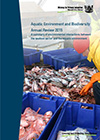Annual stock assessment
Each year, we assess the status of as many fish stocks and fisheries as possible. We assess them against the Harvest Strategy Standard for New Zealand Fisheries.
Status of New Zealand's fisheries stocks 2019 [PDF, 2.3 MB]
The Harvest Strategy Standard for New Zealand Fisheries 2008 [PDF, 309 KB]
Find out more
Guidelines for the release of fisheries information [PDF, 712 KB]
Detailed stock status information for individual stocks
Who to contact
If you have questions about fisheries science and research, email info@mpi.govt.nz








